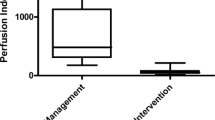Abstract
1. Stop injection/infusion immediately
2. Get extravasation kit
3. Put on (sterile) gloves
4. Replace infusion lead or syringe with 5 ml disposable syringe and aspirate slowly as much as possible of the extravasated drug; Cave! do not exert pressure on extravasation area
Access this chapter
Tax calculation will be finalised at checkout
Purchases are for personal use only
Similar content being viewed by others
Original articles
Cabriales S, Bresnahan J, Testa D, et al: Extravasation of liposomal daunorubicin in patients with AIDS-associated Kaposi s sarcoma: a report of four cases. Oncol Nurs Forum 25: 67–70, 1998.
Guaglianone P, Chan K, Hanisch R, et al: Phase I clinical trial of liposomal daunorubicin (Daunoxome) in advanced malignancies. Proc ASCO 11: 135, 1992.
Sharma D, Muggia F, Lucci L, et al: Liposomal daunorubicin (VS103): tolerance and clinical effects in AIDS-related Kaposi’s sarcoma (KS) during a phase I study. Proc ASCO 9: 4, 1990.
Secondary literature
Stanley A: Managing complications of chemotherapy administration. In: Allwood M, Stanley A, Wright P (eds) The Cytotoxics Handbook. Radcliffe Medical Press, 4th edition: 119–193, 2002.
Mullin S, Beckwith MC, Tyler LS: Prevention and management of antineoplastic extravasation injury. Hosp Pharm 35: 57–76, 2000.
van Gemmern R: Gewebstoxizität und Paravasatbehandlung neuer Zytostatika. Krankenhauspharmazie 17: 471–473, 1996.
Bertelli G: Prevention and management of extravasation of cytotoxic drugs. Drug Safety 12: 245–255, 1995.
Schneider G: Paravasate von Zytostatika. Diagnostik und Therapie. Aina S. Schneider Verlag, 6th edition: 1–17, 1999.
Dorr RT: Antidotes to vesicant chemotherapy extravasations. Blood Rev 4: 41–60, 1990.
Summary of product characteristics Daunoxome® (Germany), Gilead Sciences, March 2003.
Krämer I, Stützle M: Zytostatika-Paravasation – Wie ist vorzugehen? Krankenhauspharmazie 23: 261–268, 2002.
Jordan K, Grothe W, Schmoll HJ: Paravasation von Zytostatika: Prävention und Therapie. Dtsch Med Wochenschr 130: 33–37, 2005.
Author information
Authors and Affiliations
Rights and permissions
Copyright information
© 2010 Springer-Verlag/Wien
About this chapter
Cite this chapter
Mader, I., Fürst-Weger, P., Mader, R., Nogler-Semenitz, E., Wassertheurer, S. (2010). Daunorubicin liposomal. In: Extravasation of Cytotoxic Agents. Springer, Vienna. https://doi.org/10.1007/978-3-211-88893-3_27
Download citation
DOI: https://doi.org/10.1007/978-3-211-88893-3_27
Publisher Name: Springer, Vienna
Print ISBN: 978-3-211-88889-6
Online ISBN: 978-3-211-88893-3
eBook Packages: MedicineMedicine (R0)




